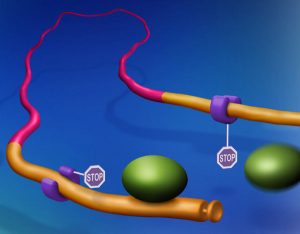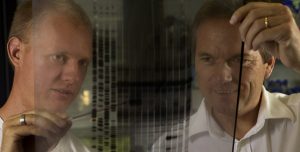A double punch for female survival

Achieving equality between the sexes can be a challenge even for single cells. Since evolution began removing bits of male DNA to create the ‘Y’ chromosome, males have had a single copy of certain key genes on the X chromosome, whereas females have two. Normally this would lead females to produce twice the amount of some proteins, which could be fatal, but cells have developed ways to prevent this. Researchers at the European Molecular Biology Laboratory [EMBL] in Heidelberg have now made a breakthrough in understanding how this balance, called ‘dosage compensation,’ is maintained. They have discovered a unique double-locking mechanism which prevents the production of a molecule that would be fatal for female cells; their work is reported in the current issue of Cell.
Genes are used to create mRNA molecules, which are then used to create proteins. “Cells build a machine called a ribosome on an mRNA to transform its information into proteins,” Hentze says. “We’ve known that a protein in female flies called SXL can block the work of this machine, but we didn’t know how. This study unravels how SXL prevents the synthesis of another protein, called MSL-2, which is essential in males but would kill female flies.”
An mRNA molecule is linear, with a protein-encoding part sandwiched in the middle between regulatory regions near the head and the tail. Most research has focused on interactions between the head region and the ribosome, because it is here that cells assemble a ‘docking bridge’ for the protein-synthesis machinery. Scientists have discovered other cases where protein synthesis is blocked at this head region. But this case turned out to be different. “Copies of SXL have to be attached to both ends of the msl-2 mRNA to efficiently stop the synthesis of MSL-2 proteins,” says Karsten Beckmann, a PhD student in Hentze’s lab, who headed the current project.
“To our surprise we found that the SXL molecules bound at the two ends do not directly work together, but that they help each other by acting on two separate steps. The SXL that binds to the tail of the mRNA blocks the construction of the docking bridge for the ribosome at the head end.” The second copy of SXL has a different function, he says. Single control mechanisms are often ‘leaky’, which means that ribosomes may still succeed in binding to the mRNA. These ribosomes have to be stopped, and the extra copy of SXL at the head regulatory region prevents them from negotiating their way towards the proteinencoding region in the middle.
What’s unusual is that SXL is serving as its own ‘backup’. The work by Hentze and his colleagues shows for the first time that a single regulatory molecule can deliver a ‘double punch’ to lock away the mRNA from the ribosome, thus preventing the expression of otherwise fatal proteins.
“Some diseases develop because of a disturbance in the fine-tuning of protein dosages,” Hentze says. “The control of protein synthesis is also crucial in the growth and development of animal tissues. Until a few years ago, scientists thought this happened almost uniquely at the level of genes. So it’s exciting to find an entirely new mechanism that evolved to let cells take control at the level of RNA. No one knows how widely this type of back-up mechanism is used. We’re now investigating some other contexts in which a very similar mechanism might be at work.”




